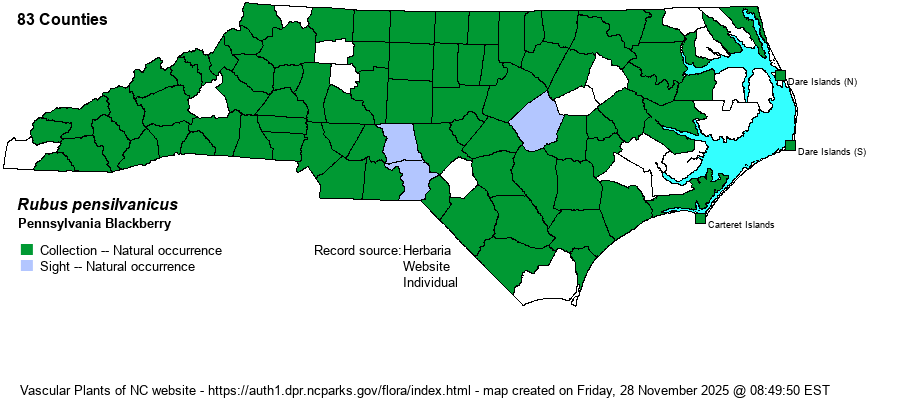| Author | Poiret | |
| Distribution | Perhaps occurs statewide, though it is scarce in a few far eastern counties. Likely occurs in all 100 counties. As the former R. argutus was recently included within R. pensilvanicus, the BONAP map for R. pensilvanicus is now incorrect; check the BONAP map of R. argutus to see the main range of this enlarged species in the state. However, in 2022, Weakley has moved at least part of the old R. argutus back out as a separate species, and thus whether the map below is still accurate is not known. In fact, a check of SERNEC records (spring 2024) shows that a given herbarium tends to have all records of this pair in one species but not the other, strongly indicating the confusing nature of which taxon truly lies in each herbarium. Probably both species lie in many herbaria.
This expanded species has a very wide range across southeastern Canada, and south to the Gulf Coast. It is likely present in nearly all counties in the eastern U.S. except in southern FL.
| |
| Abundance | Uncertain, owing to confusion with R. arbutus. Likely very common to abundant in the Piedmont and most of the Coastal Plain, as well as lower and mid-elevations in the Mountains. Not numerous in the higher Mountains nor in the far eastern counties, such as on the Outer Banks where local. | |
| Habitat | This is one of apparently two ubiquitous blackberries (along with R. argutus) of old fields, pastures, wooded margins, and other disturbed areas; many thickets are formed primarily of this species. It also grows in woodland openings. |
| Phenology | Blooms in April and May; fruits from May into July. | |
| Identification | This is one of two highly familiar blackberries over nearly all of the state, growing with long arching stems and reaching a height up to 6 feet tall. Many a biologist has been hindered doing field work by the strong prickles along the canes of this shrub. It has an abundance of thick prickles, and it typically has three or five leaflets, as do most other blackberries. It is most similar to R. allegheniensis of the mountains and foothills; however, R. pensilvanicus has glabrous flowering pedicels, as opposed to glandular (sticky) hairs on the pedicels of R. allegheniensis, which also may have glandular hairs on the stems (canes). Note that Weakley (2022) has pulled at least part or most of the old R. arbutus back out as a separate species. See that account for differences. | |
| Taxonomic Comments | The former R. argutus has recently been included within R. pensilvanicus -- see Flora of Virginia, Flora of North America website, and Weakley (2018). However, as mentioned above, Weakley (2022) moved R. argutus back out, and with both entities as named species.
| |
| Other Common Name(s) | Eastern Blackberry | |
| State Rank | S5 | |
| Global Rank | G5 | |
| State Status | | |
| US Status | | |
| USACE-agcp | FAC link |
| USACE-emp | FAC link |

